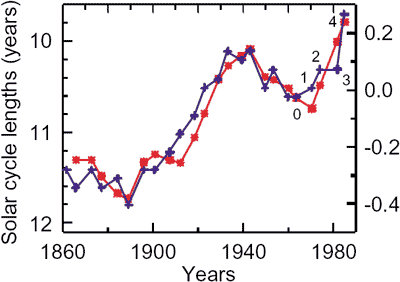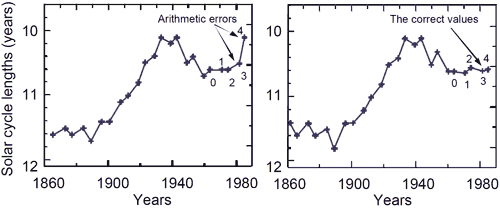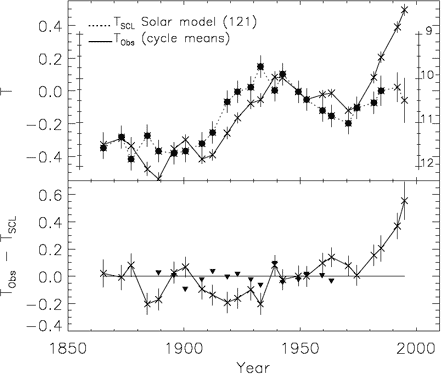What does Solar Cycle Length tell us about the sun's role in global warming?
What the science says...
The claim that solar cycle length proves the sun is driving global warming is based on a single study published in 1991. Subsequent research, including a paper by a co-author of the original 1991 paper, finds the opposite conclusion. Solar cycle length as a proxy for solar activity tells us the sun has had very little contribution to global warming since 1975.
Climate Myth...
Solar Cycle Length proves its the sun
In 1991, Eigil Friis-Christensen and Knud Lassen published an article claiming "strikingly good agreement" between solar cycle lengths (the fluctuating lengths of cycles undergone by sunspot numbers) and northern hemisphere land temperatures over the period 1860–1990 (Friis-Christensen 1991).
Solar cycle length is a useful indicator of long term changes in solar activity. When the sun gets hotter, we observe shorter solar cycles. When the sun shows a long term cooling trend, solar cycle length is longer. A 1991 study by Friis-Christensen and Lassen smoothed out data on solar cycle length and compared it to Northern Hemisphere temperature (Friis-Christensen 1991). The authors suggested the close correlation between solar cycle length and temperature supports the direct influence of solar activity on climate over the past 130 years. Note in particular the close correlation after 1980 during the modern global warming trend.

Figure 1: Changes in solar cycle length (blue crosses) versus change in Northern Hemisphere temperature (red *).
However, the solar cycle data presented in Figure 1 consists of two incongruous sets of data. The first 20 points of the graph are smoothed using a 1-2-2-2-1 running average. However, the last 4 points (marked 1 to 4 in the figure below) are not filtered in the same manner. Points 1 and 2 are only partially filtered. Points 3 and 4 are not filtered at all. In effect, it's like marrying two separate sets of data. When the latest data points are properly filtered using the latest solar data, the decrease in solar cycle length from 1980 disappears (Laut 2003).

Figure 2: Left: Original solar cycle length data from Friis-Christensen 1991. The last two points, 3 and 4 are due to errors in the authors’ arithmetic. Right: Updated solar cycle lengths using latest data from Thejll 2000.
In 1999, one of the co-authors of the original 1991 paper updated their analysis with the latest data (Lassen 1999). They found that the solar cycle length showed no trend in the last few decades of global warming. They concluded that "since around 1990 the type of Solar forcing that is described by the solar cycle length model no longer dominates the long-term variation of the Northern hemisphere land air temperature".

Figure 3: the top figure compares temperature to solar cycles. The bottom figure plots the difference between temperature and solar cycle length, showing a strong divergence in the mid 1970s (Lassen 1999).
Other studies confirm Lassen's conclusion:
- Kelly 1992 models the effects of a combination of greenhouse and solar-cycle-length forcing and compare the results with observed temperatures. They find that "even with optimized solar forcing, most of the recent warming trend is explained by greenhouse forcing".
- Laut 1998 analyses the period 1579–1987 and finds "the solar hypothesis—instead of contradicting—appears to support the assumption of a significant warming due to human activities".
- Damon 1999 uses the pre-industrial record as a boundary condition and finds the SCL-temperature correlation corresponds to an estimated 25% of global warming to 1980 and 15% to 1997.
- Benestad 2005 concludes "There have been speculations about an association between the solar cycle length and Earth's climate, however, the solar cycle length analysis does not follow Earth's global mean surface temperature. A further comparison with the monthly sunspot number, cosmic galactic rays and 10.7 cm absolute radio flux since 1950 gives no indication of a systematic trend in the level of solar activity that can explain the most recent global warming".
Claims that solar cycle length prove the sun is causing global warming are based on a single paper published nearly 20 years ago. Subsequent research, including a paper by a co-author of the original 1991 paper, finds the opposite conclusion. Solar cycle length as a proxy for solar activity tells us the sun has had very little contribution to global warming since 1975. In fact, direct measurements of solar activity indicate the sun has had a slight cooling effect on climate in recent decades while global temperatures have been rising.
Last updated on 26 October 2016 by John Cook. View Archives































 Arguments
Arguments
































denia'skeptic' arguments. So once again, a so-called 'skeptic argument' - solar cycle length - runs both hot and cold. It can be used to justify warming and cooling, as needed to suit the needs of the moment.Strictly speaking, the "What the Science Says" box at the top of this page is inaccurate: there are other papers which claim to have found a correlation between solar cycle length and temperature, such as Lassen 1995 and Reichel 2001.
jsmith - Lassen & Friis-Christensen have been repeatedly debunked, and in fact the paper you refer to is a later work by the same authors that the opening post was discussing, namely the errors made by those authors. Reichel 2001 has but 12 citations in 13 years, including three using Granger causality analysis demonstrating that natural variation including the sun is not the dominant factor in the last half century of climate change.
The statement made in the opening post, that "Solar cycle length as a proxy for solar activity tells us the sun has had very little contribution to global warming since 1975.", still holds true under examination.
I would also point out that the author of Reichel 2001 is... an economist.
jsmith regarding Lassen (1995) you probably ought to also read Thejil and Lassen (2000) (yes, that Lassen), which reports that the correlation broke down when further data became available.
Solar forcing of the Northern hemisphere land air temperature: New data
P Thejll, ,K Lassen
Abstract
It has previously been demonstrated that the mean land air temperature of the Northern hemisphere could adequately be associated with a long-term variation of solar activity as given by the length of the approximately 11-year solar cycle. Adding new temperature data for the 1990s and expected values for the next sunspot extrema we test whether the solar cycle length model is still adequate. We find that the residuals are now inconsistent with the pure solar model. We conclude that since around 1990 the type of Solar forcing that is described by the solar cycle length model no longer dominates the long-term variation of the Northern hemisphere land air temperature.
Journal of Atmospheric and Solar-Terrestrial Physics, Volume 62, Issue 13, September 2000, Pages 1207–1213
doi:10.1016/S1364-6826(00)00104-8
[emphasis mine]
Jan-Erik Solheim, Kjell Stordahl and Ole Humlum (SSH) published their papers 'Solar Activity and Svalbard Temperatures' and 'The long sunspot cycle 23 predicts a significant temperature decrease in cycle 24' early in 2012. According to SSH, their Solar Cycle Model can, based on the length of a solar cycle, predict the mean temperature in the next solar cycle for some northern regions. Later the same year I programmed their Solar Cycle Model. I got the same results as they did with their implementation of the model. When the model was run with temperature series for the northern region up to and including solar cycle 23, the results satisfied the statistical test used by SSH. A closer examination with hindcasting (backtesting) revealed that the model predicted the temperatures well until the mid-1970s, but not thereafter. I wrote about this in December 2012 here at Skeptical Science in the blog post 'Solar Cycle Model fails to predict the recent warming'.
In their papers, SSH made some specific predictions for temperatures in solar cycle 24, which had just started in 2012. In 2014 I discussed the Solar Cycle Model with the lead author Solheim on a Norwegian discussion forum. He stressed that we have to wait till solar cycle 24 has ended before we can evaluate the model's predictions for that cycle. Now it has ended. The temperatures in solar cycle 24 were higher than in the previous cycle, not colder as predicted by SSH. See more details in comment 22 in the blog post I wrote here at SkS.